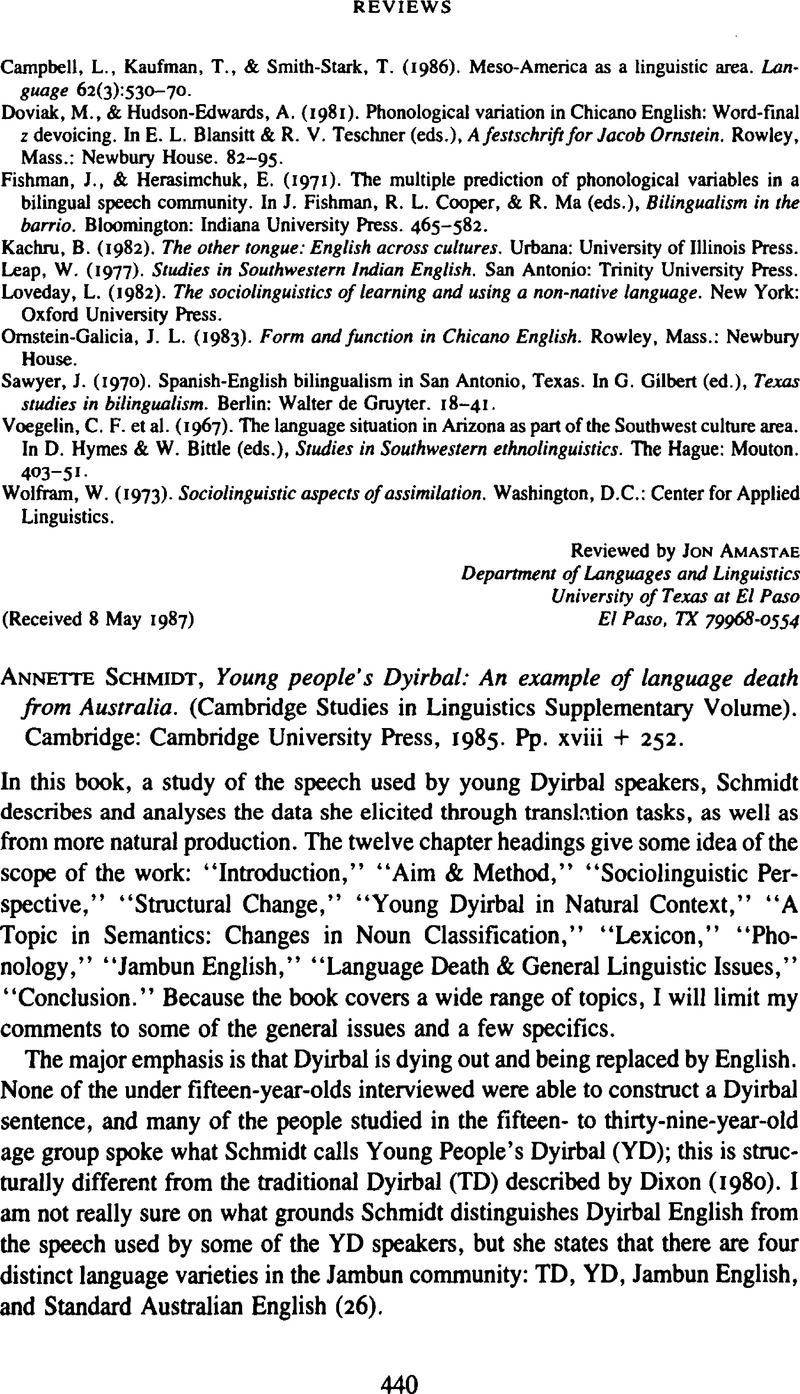No CrossRef data available.
Article contents
Annette Schmidt, Young people's Dyirbal: An example of language death from Australia. (Cambridge Studies in Linguistics Supplementary Volume). Cambridge: Cambridge University Press, 1985. Pp. xviii + 252.
Published online by Cambridge University Press: 18 December 2008
Abstract
An abstract is not available for this content so a preview has been provided. Please use the Get access link above for information on how to access this content.

- Type
- Book Review
- Information
- Copyright
- Copyright © Cambridge University Press 1988
References
REFERENCES
Bavin, E. L., & Shopen, T. (1985). Warlpiri and English: Languages in contact. In Clyne, M. (ed.), Australia: Meeting place of languages. (Pacific Linguistics Series C, 92.) Canberra: Pacific Linguistics.Google Scholar
Bavin, E. L., & Shopen, T. (1987). Innovations and neutralizations in the Warlpiri pronominal system. Journal of Linguistics 23.CrossRefGoogle Scholar
Dixon, R. M. W. (1980). The Dyirbal language of North Queensland. Cambridge: Cambridge University Press.Google Scholar
Dorian, N. (1973). Grammatical change in a dying language. Language 49:414–38.CrossRefGoogle Scholar
Dorian, N. (1977). The problem of the semi-speaker in language death. International Journal of the Sociology of Language 12:23–32.Google Scholar
Dorian, N. (1978). The fate of morphological complexity in language death. Language 54:590–609.CrossRefGoogle Scholar
Gal, S. (1979). Social determinants of linguistic change in bilingual Austria. New York: Academic.Google Scholar
Hill, J. (1979). Language death, language contact, and language function. In Wurm, S. & McCormack, W. (eds.). Approaches to language. The Hague: Mouton.Google Scholar
Hill, J., & Hill, K. (1977). Language death and reflexification in Tlaxcalan Nahuatl. International Journal of the Sociology of Language 12:55–69.Google Scholar
King, R. (1984). Linguistic variation and language contact: A study of French spoken in four Newfoundland communities. In Warkentyne, H. J. (ed.), Papers from the Fifth International Conference on Methods in Dialectology. Victoria, B.C.: University of Victoria.Google Scholar
Mithun, M. (forthcoming). The incipient obsolescence of polysynthesis: Cayuga in Ontario and Oklahoma. In Dorian, N. (ed.), Investigating obsolescence: Studies in language contraction and death. Cambridge: Cambridge University Press.Google Scholar
Mougeon, R., Beniak, E., & Valois, D. (1985). A sociolinguistic study of language contact, shift and change. Linguistics 23:455–87.CrossRefGoogle Scholar
Tsitsipis, L. D. (1983). Narrative performance in a dying language: Evidence from Albanian in Greece. Word 34:25–36.CrossRefGoogle Scholar
Tsitsipis, L. D. (1984). Functional restriction and grammatical reduction in Albanian language in Greece. Zeitschrift fur Balkanologie 20:122–31.Google Scholar




